| Place Name, Omachi:(大町) |
Many houses, workshops, and stalls once stood along a street called Omachi-oji (大町大路) so that the area itself came to be called Omachi. Around present-day Omachi Yotsukado (大町四つ角), the point where Omachi-oji and Komachi-oji (小町大路) Streets crossed, people traded various goods making it a busy quarter in the Kamakura period. The two streets were also important transportation routes.
| Myohonji Temple (妙本寺) |
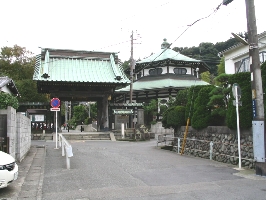
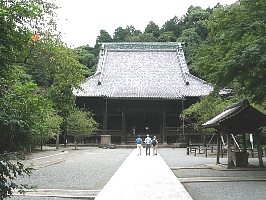
Full name: Chokozan Myohonji (長興山 妙本寺)
Denomination: Nichiren sect (日蓮宗)
Location: 0.4 kilometers southeast of JR Kamakura Station
History: In the Kamakura period, a powerful clan, named Hiki had their residence in this valley. The head of them was Hiki Yoshikazu (比企能員, ?-1203). He was a senior official of the Kamakura bakufu (幕府). The present-day peacefulness of the valley belies a tragic event that led to the destruction of the clan and the death of the wife and one son of Minamoto no Yoriie (源頼家, 1182-1204), the second shogun.
Ironically, it was the strong ties between the Hiki clan and the Kamakura shogunate that brought about their downfall. One such tie was that Yoshikazu's foster mother, known as Hiki no Ama (比企の尼), was a wet nurse to Minamoto no Yoritomo (源頼朝, 1147-99). In this connection, Yoshikazu came to serve Yoritomo and played an active role in the government. Furthermore Yoshikazu's wife became a wet nurse to Yoriie and Yoshikazu's daughter, Wakasa no Tsubone (若狭の局), became Yoriie's wife. She gave birth to a boy, Ichiman (一幡, 1197-1203), who was brought up in the Hiki family. Thus, Hiki Yoshikazu, as the grandfather of Ichiman, posed a great threat to the rival Hojo.
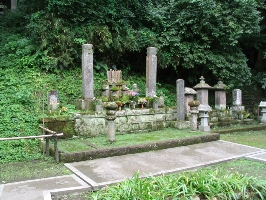 When in 1203, Yoriie, the second shogun, fell seriously ill, a dispute broke out between the Hiki and Hojo over who should succeed him. While the Hojo recommended Semman (千幡), who later actually became the third shogun, Minamoto no Sanetomo (源実朝, 1192-1219), the Hiki naturally supported Ichiman.
When in 1203, Yoriie, the second shogun, fell seriously ill, a dispute broke out between the Hiki and Hojo over who should succeed him. While the Hojo recommended Semman (千幡), who later actually became the third shogun, Minamoto no Sanetomo (源実朝, 1192-1219), the Hiki naturally supported Ichiman.One day, Hojo Tokimasa (北条時政, 1138-1215) cunningly invited Yoshikazu to his residence on a trumped up pretext. No sooner had Yoshikazu entered the house than he was attacked and killed. Upon hearing of this, the Hiki assembled around the six-year-old Ichiman in Hikigayatsu to form a defense against the combined armies of the Hojo, Hatakeyama (畠山), Miura (三浦), and Wada (和田), but in the ensuring battle the Hiki were defeated and their estate burned down. Thus, Ichiman came to tragically lose his life. His mother, Wakasa no Tsubone, soon after drowned herself in a nearby well in despair.
The founding of Myohonji Temple started some 50 years after this tragic event. A redeeming aspect of it was that Hiki Yoshimoto (比企能本, 1202?-86?), the youngest son of Yoshikazu, managed to escape after the battle. Taken to Kyoto, he later became a scholar and served at the court. Eventually he was able to return to Kamakura when his niece (Yoriie's daughter) became the wife of Fujiwara no Yoritsune (藤原頼経, 1218-56), the fourth shogun there. Later, Yoshimoto became a disciple of Nichiren (日蓮, 1222-82), the founder of the Nichiren sect of Buddhism.
After Nichiren's death, Yoshimoto built a hall, the origin of Myohonji Temple, here for the repose of his master's soul as well as for the souls of the Hiki. In 1260, Nichiro (日朗, 1245-1320), a leading Nichiren disciple, had a full-scale temple built. Since then, the temple has been among the highest ranking temples of this sect. Until the Second World War, the chief priest of Ikegami Hommonji Temple (池上本門寺) in Tokyo used to serve concurrently as the chief priest of this temple.
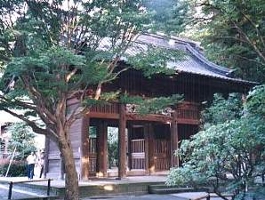
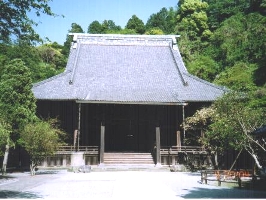
Grounds and structures: Ebisudobashi Bridge (恵比寿堂橋), spanning the Namerigawa River (滑川) is the approach to the temple. Beyond the bridge stands a large stone monument inscribed with the characters, "南無妙法蓮華経, Namu-Myoho-Rengekyo," and "妙本寺." These characters, the sacred formula for the Nichiren sect (日蓮宗) of Buddhism, are called daimoku (題目).
The main gate to the temple is at the end of this approach The valley ahead has long been called Hikigayatsu (比企ケ谷), because the Hiki clan (比企) once lived in this area, which despite being close to busy streets still retains a serene and peaceful atmosphere. Beyond the main gate and to the right is an octagonal-shaped building. Formerly a sub-temple of Myohonji called Daienbo (大円坊), it is now the Hikigayatsu Kindergarten (比企ケ谷幼稚園).
At the end of a cedar-lined approach and at the top of stone steps stands a large vermilion Nitemmon Gate (二天門). In a recess on each side stands an image of a fierce-looking god, Jikokuten (持国天) on the left and Bish monten, (毘沙門天, a.k.a. Tamonten, 多聞天) on the right (as you face them).
In the center of the grounds beyond the gate is Founder's Hall, (Soshido, 祖師堂). In its center is an elaborately-built inner shrine, Gokuden (御宮殿). Right of it are statues of Nichiro, and Hiki Yoshikazu and his wife, and to the left are a statue of Nichirin (日輪), the second chief priest of the temple, as well as statues of Hiki Yoshimoto and his wife.
Reihoden Hall (霊宝殿) on the left side of Founder's Hall also holds temple treasures. (Not open to public viewing). One is a seated statue of Nichiren, once the highest object of worship when it was enshrined in Founder's Hall. It is one of three statues carved from the same column of wood and made as life-like as possible. The other two statues are kept in Minobusan (身延山) and Hommonji, respectively.
Another treasure is a bronze, cloud-shaped gong called umpan (雲版), used for announcing the hour, and is inscribed 建武四年 (1337). The gong has been designated an Important Cultural Property. A statue of Shaka Nyorai brought from Shin Shakado Hall (新釈迦堂) is also housed here. There are many other treasures related to Nichiren and Nichiro.
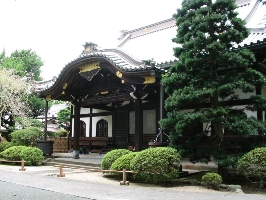 To the left side of the grounds and up on the hillside stands a vermilion-lacquered belfry. The Main Hall and the living quarters of the chief priest are also on the left side of the grounds. A wooden Hokan Shaka Nyorai (宝冠釈迦如来, Jeweled-Crown Shaka Nyorai), made in the Muromachi period (1336-1573), is enshrined in the Main Hall. The Nitemmon Gate and Founder's Hall were built during the Tempo era (天保, 1830-1844) in the Edo period (1603-1867), and are the temple's oldest structures.
To the left side of the grounds and up on the hillside stands a vermilion-lacquered belfry. The Main Hall and the living quarters of the chief priest are also on the left side of the grounds. A wooden Hokan Shaka Nyorai (宝冠釈迦如来, Jeweled-Crown Shaka Nyorai), made in the Muromachi period (1336-1573), is enshrined in the Main Hall. The Nitemmon Gate and Founder's Hall were built during the Tempo era (天保, 1830-1844) in the Edo period (1603-1867), and are the temple's oldest structures.| Ichiman no Sodezuka (一幡の袖塚, or Ichiman's Sleeve Tomb) |
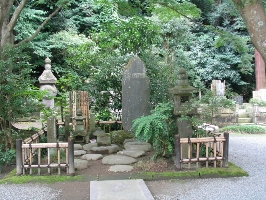
To the right behind the Nitemmon Gate is a spot where moss-covered stupa constructed of five stone section and other small stone monuments stand within a fenced area.
On a stone monument is written "一幡の袖塚 (Ichiman no Sodezuka)," literally, "Ichiman's Sleeve Mound,"a reminder of the tragic event that befell this son of the second shogun, Yoriie.
He was only three years old when Hojo Yoshitoki's soldiers attacked his mother's family, burned down their estate and annihilated them. Afterwards, nothing of Ichiman was found except for a piece of his sleeve. In due time it was buried here in place of his remains. Other members of the Hiki are commemorated by tombs on the hillside.
| The Former Site of Shin Shakado Hall (新釈迦堂跡) |
To the left of Founder's Hall stands a stone monument dedicated to the memory of Sengaku (仙覚, 1203-?). Sengaku, a poet and monk, is known as a scholarly student of the Man'yoshu (万葉集), the oldest Japanese anthology of poetry.
Further up to the left is a clearing, where there used to be a hall called Shin Shakado (新釈迦堂). It was in this hall that he studied the Man'yoshu and completed a 20-volume work of notes in 1269. He is said to have laid the foundation for all of its future studies.
| Jakushi Myojin Shrine (蛇苦止明神) |
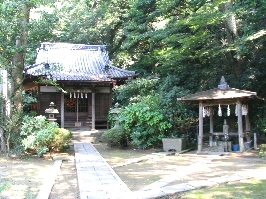
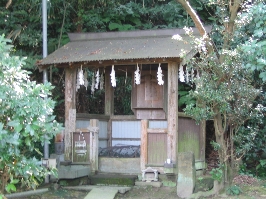
The shrine is tucked away to the left of the cedar-lined approach to the upper grounds of Myohonji Temple. It is dedicated to Jakushi Myojin, a name that literally means "God For Serpent Sufferer's Relief."
A story about Jakushi Myojin goes back to the time when the Hiki family perished at the hands of the Hojo. Wasaka no Tsubone, a Hiki and wife of Yoriie, the second shogun, threw herself into the well within these grounds. Her spirit is said to have been transformed into a serpent.
Soon after her death, a daughter of Hojo Masamura (北条政村, 1205-73), the seventh regent, was possessed by this spirit of Wakasa no Tsubone, and writhed in agony like a snake.
To rid her of her suffering, Masamura requested a high-ranking priest to pray to the spirit of Wakasa no Tsubone for mercy and had a small shrine built. His daughter, it is said, soon recovered.
In this connection, the well came to be called "Jagyo no I" (蛇形の井), literally, "Snake-Shape Well."
| Joeiji Temple (常栄寺) |
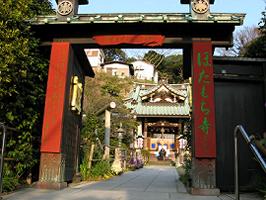
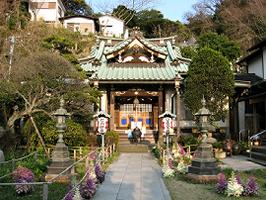
Full name: Eunzan Joeiji (恵雲山 常栄寺)
Denomination: Nichiren sect (日蓮宗)
Location: 0.5 kilometers southeast of JR Kamakura Station
History: The temple is also popularly called Botamochi-dera (ぼたもち寺), botamochi being a Japanese rice dumpling covered with a jam made from beans. (More will be said about the nickname's origin later.)
Minamoto no Yoritomo once had a look-out stand (sajiki, 桟敷) built on the temple's back hill for his enjoyment of the scenery of Yuigahama Beach.
In later years, a nun who took up residence here and popularized the temple, came to be known as Sajiki no Ama, (桟敷の尼, a.k.a. Sajikini, 桟敷尼) in association with Yoritomo's sajiki.
A firm believer in the Nichiren sect of Buddhism, Sajikini seized an opportunity to demonstrate her faith by offering its founder, Nichiren, some sesame-flavored botamochi, on September 12 in 1271, as he was being led off to the execution grounds at Tatsunokuchi (竜ノ口) near Enoshima, praying that Buddha would protect him.
Because Nichiren was miraculously saved just as he was about to be executed, people soon came to think her dumplings had caused the miracle and began calling them "Nichiren-Saving-Dumplings."
To praise Sajiki no Ama's devotion to Nichiren, Nissho (日詔), the fourteenth Chief Priest of Myohonji and Hommonji Temples, rebuilt the once-abandoned temple here in 1606.
It was initially a prestigious seminary for priests, and was named Joeiji (常栄寺) after Sajikini's posthumous Buddhist name, Myojo-Nichiei (妙常日栄). Destroyed once, the temple was later rebuilt by Nittsu (日通) in the late Edo period.
Even now, every September 12th, on the day called Gohonan'e (御法難会, Nichiren's Persecution Day), dumplings from this temple are offered to statues of Nichiren at Ryukoji (竜口寺) and Myohonji.
Grounds and structures:
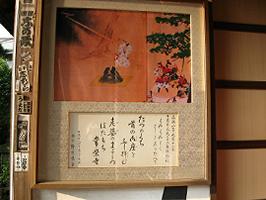
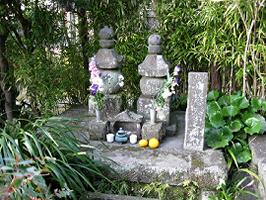
At the top of a few stone steps is a black-lacquered gate. Each of the two gateposts has a vermilion lacquered panel carved in Kamakura-bori style (鎌倉彫). Such panels hung on posts are called ren (聯). The panel carving on the right says Botamochi-dera Joeiji (ぼたもち寺 常栄寺) and the one on the left is a 31-syllable Japanese poem (waka, 和歌).
The grounds are small but neatly kept. The structure in front is the Main Hall. Two gorinto-type tombstones stand side by side on the left and are for Sajiki no Ama and her husband, Saemon no Jo Sukenobu (左衛門尉祐信).
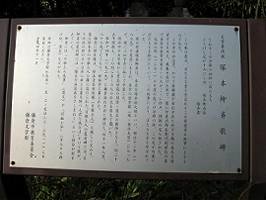
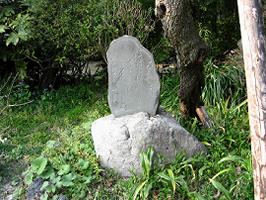
Sajiki was supposedly a younger sister of Hiki Yoshikazu's wife. (see Myohonji Temple.) Sukenobu, on the other hand, served Prince Munetaka (宗尊親王, 1252-66), the sixth shogun in Kamakura.
On the right is the temple office and priest's living quarters. A monkey-like object visible on the roof is there to ward off evil.
The three central objects of worship in the Main Hall are collectively called Sambo-soshi (三宝祖師) and consist of a tablet inscribed Namu-Myoho-Rengekyo, (南無妙法蓮華経), which in turn is called odaimoku (お題目, sacred formula), and images of Shaka Nyorai (釈迦如来) and Taho Nyorai (多宝如来). Enshrined in front of those three objects is an image of Nichiren, flanked by images of Kishimojin (鬼子母神) and Sajikini.
Two other treasures the temple possesses are a wooden bowl for making dumplings, and a pot for blackening the teeth (ohaguro-tsubo, おはぐろ壷), both of which are said to have been used by Sajikini herself.
The temple crest, called "maru ni sasarindo, 丸に笹りんどう," consists of three gentian flowers and five stylized bamboo leaves all arranged in a circle. The temple is able to use the crest because of the connection with Yoritomo, who had the above-mentioned lookout-stand built nearby and visited the grounds here.
| Geba (下馬) |
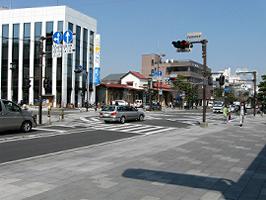
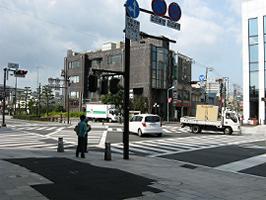
The area around the crossroad between Wakamiya-oji Avenue (若宮大路), which runs north and south, and the road which runs from Hase to Nagoe, is now called Geba. The crossroad itself is called Geba Yotsukado (下馬四つ角).
Wakamiya-oji Avenue was the main thoroughfare in old Kamakura and this area was once called Shimo no Geba (下の下馬), along with Naka no Geba (中の下馬) and Kami no Geba (上の下馬), which were located around the south and north ends of present-day Dankazura (段葛), respectively. A stone monument on the left side of the intersection (when facing the beach) now marks the site of Shimo no Geba.
Geba literally means "dismount." In the Kamakura period, a mounted warrior, whatever his rank, had to dismount here when he approached Hachimangu Shrine. Accordingly, this location came to be called Geba.
| Emmeiji (延命寺) and Migawari Jizo (身代り地蔵) |
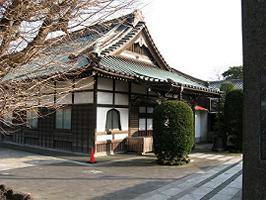
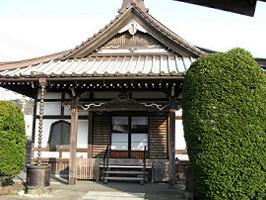
Full name: Kimyosan Emmeiji (帰命山延命寺)
Denomination: Jodo sect (浄土宗)
Location: 0.4 kilometers south of JR Kamakura Station
History: The temple was founded by the wife of Hojo Tokiyori (北条時頼, 1227-63), the fifth regent, and its first chief priest was Shoyo Noko (昌誉能公), a high priest of the Jodo sect.
Grounds and structures: A large ginkgo tree stands on the left. Ahead is the Main Hall, which houses an image of Amida Nyorai (阿弥陀如来), with attendants Kannon (観音) to the right and Jizo Bosatsu to the left.
This Jizo Bosatsu, standing on a game board, is popularly called Migawari Jizo, "Substitute Jizo." How it got this name makes for an interesting story.
One day, it is said, Tokiyori and his wife were amusing themselves by playing a game called Sugoroku, (双六), much like the game of Backgammon, in which a board, pieces, and dice are used. The two had a wager that the loser would have to remove his or her clothes.
With the odds being against the wife, she prayed to Jizo for help. To her amazement, Jizo then appeared, naked, on the Sugoroku board, seemingly in her stead. This miraculous event extricated the wife from her predicament, and from that day on she worshiped Jizo more than ever.
The statue, somewhat graphic, is said to have been carved by Unkei (運慶, ?-1223), a famous sculptor in the Kamakura period. In those days, people were so eager to meet a "living" Buddha that they had statues made as realistic as possible, and eventually even naked ones.
The Jizo and Benzaiten (弁才天) in Hachimangu are good examples, although they usually are clothed.
Even now, this Jizo on the boardis wrapped in the robe of a Buddhist priest and is popularly worshiped as a "Substitute Jizo."
| Kyoonji Temple (教恩寺) |
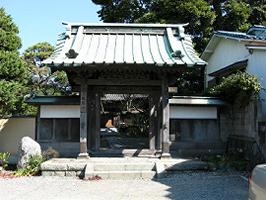
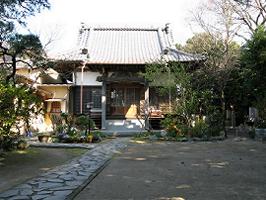
Full name: Nakazasan Kyoonji (中座山教恩寺)
Denomination: Ji sect (時宗)
Location: 0.5 kilometers southeast of JR Kamakura Station
History: The temple was originally founded by Chia (知阿) within the grounds of Komyoji Temple in Zaimokuza at the behest of Hojo Ujiyasu (北条氏康, 1515-71), the third Lord of Hojo in Odawara. In 1678, Kiyo (貴誉), a priest, moved it to this compound.
Grounds and structures: Nondescript at first glance. A closer look, however, reveals another aspect. The gate, for example, is simple, but on its beam are carvings of 16 of Buddha's disciples, Juroku Rakan (十六羅漢), or Sixteen Arhats.
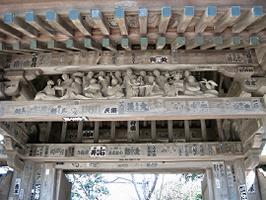
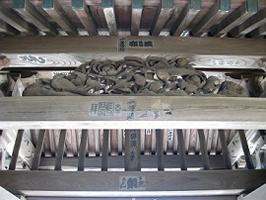
The main image in the hall, a statue of Amida Nyorai, is attributed to Unkei, although the only certainty is that it and the two attending Bosatsu were made in the early Kamakura period, and are designated Important Cultural Properties by Kanagawa Prefecture.
The following story is often told about this statue and Yoritomo.
When the Taira (平) were virtually destroyed, Taira no Shigehira (平重衡, 1156-85), a son of Taira no Kiyomori (平清盛, 1118-81), was captured and sent to Kamakura. Minamoto no Yoritomo showed mercy on him and presented him with this statue of Amida so that he might pray for the departed souls of the Taira. From that time on, Shigehira developed a deep faith in this Amida.
In addition to the statues, Kyoonji Temple possesses an old vessel that was found buried here filled with coins imported from China in the Sung (宋) and Ming (明) dynasties. The coins were in circulation in the Kamakura and Muromachi periods. They are, unfortunately, not open to public viewing.
| Yakumo Jinja Shrine (八雲神社) |
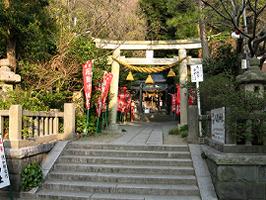
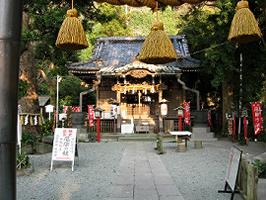
Location: 0.6 kilometers southeast of JR Kamakura Station
Enshrined deity: Three gods, Susanoo no Mikoto (須佐之男命), Inadahime no Mikoto (稲田比売命), and Hachioji no Mikoto (八王子命)
History: Yakumo Shrine, one of the oldest shrines in Kamakura, was originally called Gion Tennosha (祇園天王社), and for the following reason.
In the eleventh century there was a warrior of note named Shinra Saburo Yoshimitsu, (新羅三郎義光, a.k.a. Minamoto no Yoshimitsu, 源義光, 1045-1127). To conquer the rebelling Abe (安倍) in Oshu (奥州, present-day Tohoku), he departed Kyoto for the battlefront to assist his brother, Minamoto no Yoshiie (源義家, 1039-1106). (The battle is called the Later Three Year War, 後三年の役).
Yoshimitsu, on his way to Oshu, sojourned in Kamakura, where he saw many people suffering from an epidemic. To save them from their plight, he had a shrine built consecrated to the three deities of Kyoto Gionsha (京都祇園社).
Now, local people in Omachi worship them as guardian deities of their area and refer to the shrine as Yakumosan (八雲さん) or Otennosan (お天王さん).
Grounds and structures:
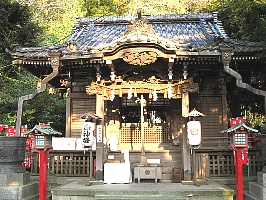
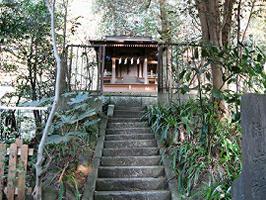
Beyond two stone torii (鳥居) shrine gates is an open space. Ahead is the Main Hall, on the left a treasure repository, and behind the Main Hall is Mitsumine Shrine (三峰神社).
In the repository are four portable shrines, mikoshi (神輿), the main treasures of this shrine, made in the Edo period.
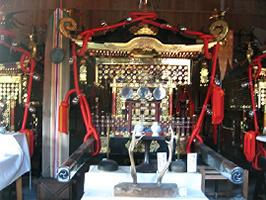
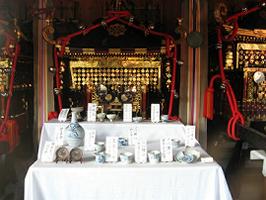
Numerous other precious objects such as swords, bronze mirrors are displayed, along with roof tiles, some vessels, and other minor items, plus a mask of Sarutahiko, 猿田彦, the deity regarded as a protector of travelers in connection with his role as guide to the gods in their descent from Heaven, a story which is told in the birth-myth of the country.
Within the grounds is another shrine, this one for Inari (稲荷), the god of good harvest.
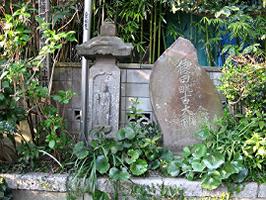
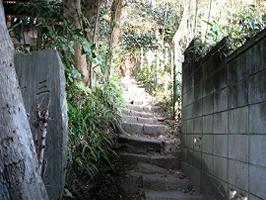
A koshinto-type stone monument (庚申塔) bearing the year name 寛文十年 (corresponding to 1670) stands by the approach.
From the right side of the grounds a path leads into the back hills. This is the Gionyama Hiking Course (祇園山ハイキングコース), which runs from yakumo Shrine to the former site of Toshoji Temple.
| Betsuganji Temple (別願寺) |
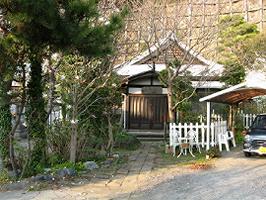
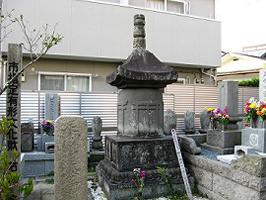
Full name: Tokasan Betsuganji (稲荷山別願寺)
Denomination: Ji sect (時宗)
Location: 0.6 kilometers southeast of JR Kamakura Station
History: Originally, the temple was called Nojoji (能成寺) and belonged to the Shingon sect. In 1282, when the chief priest, Kakua (覚阿), became a disciple of Ippen (一遍, 1239-89), Kakua converted the temple to the Ji sect and changed the name to Betsuganji.
The temple is small now, but in the Muromachi period was larger. In those days it was the family temple of successive Kamakura Kubo (公方) from the Ashikaga clan.
Grounds and structures: The grounds are not large and a small hall houses a statue of Amida Nyorai.
A 3.2-meter-high stone stupa stands in the graveyard to the left of the Main Hall, as if mirroring the size of the original temple.
Of a type called hoto (宝塔), literally "treasure pagoda," it is very old, and, because of the four doors (one for each of the four directions of the compass) on its circular surface that are etched to appear as part of a torii, it is also very rare. It bears the inscription 永亨11年 (corresponding to 1439). The stupa is said to have been built in the Muromachi period as a memorial to Ashikaga Mochiuji (足利持氏, 1398-1439) although it seems older, for its style suggests the latter part of the Kamakura period.
Other temple treasures are ten ancient writings, including Letters of Donation written by Ashikaga Ujimitsu (足利氏満, 1359-98), Mitsukane (満兼, 1378-1409), and Mochiuji. They are not open to public view.
| Jogyoji Temple (上行寺) |
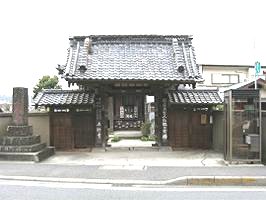
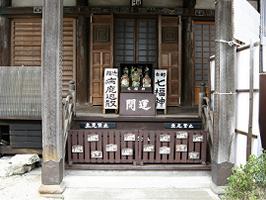
Full name: Hokyuzan Jogyoji (法久山上行寺)
Denomination: Nichiren sect (日蓮宗)
Location: 0.6 kilometers southeast of JR Kamakura Station
History: The temple was founded by Nippan (日範) in 1313. The Main Hall, originally the Hokkedo Hall (法華堂) of Myohoji Temple (妙法寺) in Nagoe, was moved here in 1886.
Grounds and structures:
The Main Hall is behind the main gate and is said to have been built by the Hosokawa (細川) family, once the feudal lords of Kumamoto.
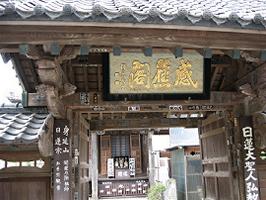
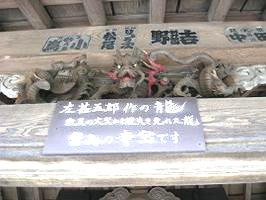
A transom under the gate eaves holds elaborately carved dragons. On the ceiling of the Main Hall are painted flowers and birds, and carvings of the twelve animal of the Chinese zodiac adorn its transoms.
The principal image of the temple is Sambo-soshi. A statue of Nichiren is enshrined in the center and a statue of Nippan, the founder of the temple, is on the left of Nichiren.
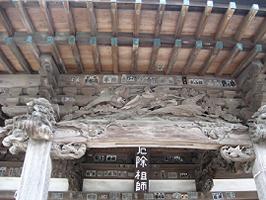
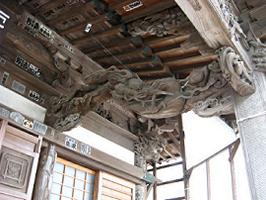
To the left of the Main Hall is a cemetery which contains the grave of Hiroki Matsunosuke (広木松之助), a lordless samurai of the Mito clan (水戸藩).
In 1860, he and his group attacked and killed Ii Naosuke (井伊直弼, 1815-60), a high official of the Edo bakufu, outside the Sakuradamon Gate (桜田門) of Edo Castle. These samurai strongly opposed the opening of the country. To their way of thinking, assassinating one of its foremost proponents would stop the government policy. After the incident, Hiroki fled to Kamakura, took refuge in this temple and in the end committed hara-kiri. The monument to Hiroki was erected in 1916.
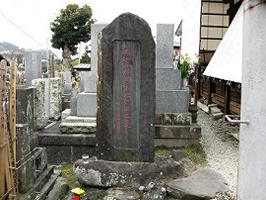
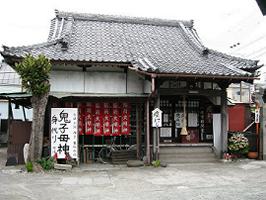
On the right side of the Main Hall are two other halls. One, Inarido Hall (稲荷堂), enshrines Kasamori Inari (瘡守稲荷), who allegedly cures boils and other afflictions. The other is Yakushido Hall (薬師堂), which enshrines a large and a small statue of Kishimojin (鬼子母神).
| An'yoin (安養院) |
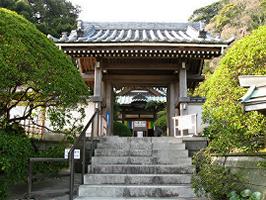
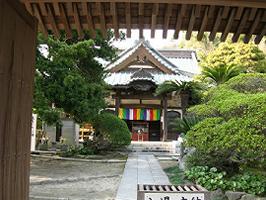
Full name: Gionsan An'yoin (祇園山安養院)
Denomination: Jodo sect (浄土宗)
Location: 0.7 kilometers southeast of JR Kamakura Station
History: The history of An'yoin is somewhat complicated. Originally, there was a temple called Zendoji (善導寺), founded by Sonkan (尊観), which belonged to the Jodo sect. In the last years of the Kamakura period, Zendoji was renamed An'yoin Chorakuji (安養院長楽寺) as a re-incarnation of Chorakuji Temple in Hase, which had burned down and long been abandoned. This name, An'yoin, is the posthumous Buddhist name of Hojo Masako, who had built the original Chorakuji in memory of her husband, Yoritomo.
In 1680, when An'yoin Chorakuji was destroyed in a fire, the Tashiro Kannondo Hall (田代観音堂) of Tashiroji Temple (田代寺) at Hikigayatsu was transferred here. The original hall was founded by Tashiro Nobutsuna (田代信綱), a vassal of Yoritomo.
Grounds and structures:
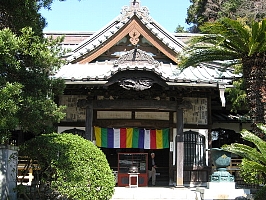
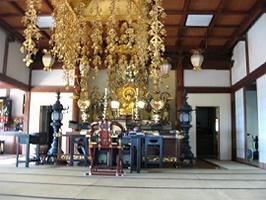
On the left side behind the main gate is a small Jizodo Hall (地蔵堂) and the Main Hall stands beyond the approach. The grounds are modest and quiet.
In the Main Hall, a statue of Amida Nyorai is enshrined as the main image. Standing behind it is a 1.85-meter-tall Senju Kannon (千手観音, Thousand-Armed Kannon) brought from Tashiroji Temple. To the left of Amida Nyorai are statues of Bishamonten (毘沙門天, one of the Kamakura and Enoshima Seven Deities of Good Fortune), and likenesses of Hojo Masako, Honen (法然) and Zendo (善導).
Behind Amida Nyorai are statues of Gangyo (願行) and Sonkan, while to the right are a statue of Shakyamuni at birth, a drawing depicting the scene of Shakyamuni's death, Nehanzu (涅槃図), and Masako's memorial tablet with her posthumous name "安養院如実妙観大禅定尼, An'yoin-Nyojitsu-Myogan-Daizenjoni."
The Senju Kannon is also called Shoryu Kannon (昇竜観音, "Ascending Dragon" Kannon), or Ryoen Kannon (良縁観音, "Good Match" Kannon). People who hope for career advancement or matrimonial success come to worship. How this Kannon came to gain such a reputation is explained in the following story.
Tashiro Nobutsuna (mentioned above) put his faith in this Kannon and always took it with him when he went into battle, for he believed that his martial success proceeded from its grace.
From the time Yoritomo took up arms against the Taira, Nobutsuna pledged him his fealty and was among the handful of faithful followers who, together with Yoritomo, hid themselves in a cave to elude their pursuers after their defeat at Mt. Ishibashi near Hakone. ( He pledged fealty to Yoritomo from the time the latter took up arms against the Taira. Upon defeat at Mt. Ishibashi (石橋山) near Hakone, Yoritomo and a handful of followers, including Nobutsuna, hid themselves in a cave, narrowly eluding their pursuers.)
In the years that followed, Nobutsuna distinguished himself in battle. Hojo Masako also deeply worshiped this statue, believing that her marriage to Yoritomo and his successes were due to its benevolence. Following consultations with her, Nobutsuna eventually built the Tashiroji Temple and enshrined the statue in the Kannondo Hall within the grounds. The statue now stands here and attracts many worshippers who come in the hope of sharing similar good fortune.
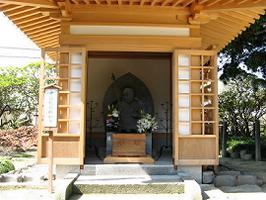
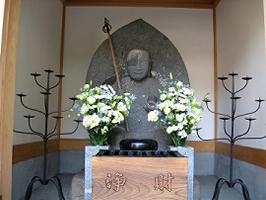
A stone Jizo called Higiri Jizo (日限地蔵), "Time-Limiting Jizo" is in a small hall by the gate and dates from the fifteenth century. Those who visit and pray "within a set time" will have their prayers answered. Another name for the statue is Koyasu Jizo (子安地蔵), "Easy-Child-Delivery Jizo."
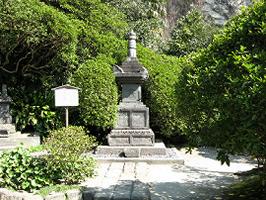
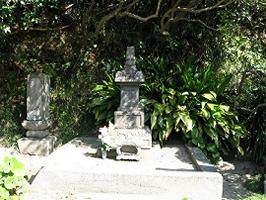
Two hokyoino-type stupas (宝篋印塔) stand behind the Main Hall. Access is from the left side of the Main Hall.
The larger stupa is on the right of the tomb of Sonkan, the founder of Zendoji, the predecessor of this temple, and was made in the late Kamakura period. It bears the date 徳治三年 (corresponding to 1308). Reputedly the oldest stupa among the dated ones in Kamakura, it is designated an Important Cultural Property.
The smaller stupa is on the left and, because of its style, is thought to have been built in the Muromachi period for the repose of Hojo Masako's soul. It is inscribed 安養院殿 (An'yoinden) and 嘉禄元年七月十三日 (corresponding to 1225), although that year falls within the Kamakura period, and the inscription is presumed to have come later.
People visit this temple primarily because of its association with Masako. The temple is also noted for its azaleas from spring to early summer.
| Tsuji no Yakushido Hall (辻の薬師堂) |
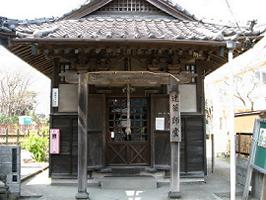
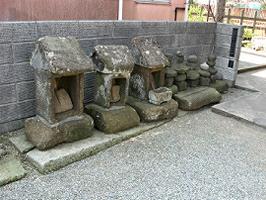
Location: 0.7 kilometers south-southeast of JR Kamakura Station
Grounds and structures: Yakushido Hall, once owned by Chozenji Temple (長善寺), itself long since gone, houses numerous statues, most of them replicas.
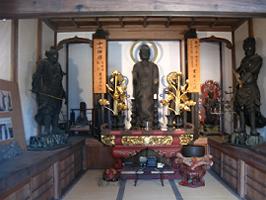 The original statues are on loan to the Kamakura Kokuhokan within the grounds of Tsurugaoka Hachimangu and include Yakushi Nyorai (薬師如来), the main image, made in the late Heian period (794-1185/92); Nikko Bosatsu (日光菩薩) and Gakko Bosatsu (月光菩薩), attendants of Yakushi, made in the Muromachi period; and Juni Shinsho (十二神将), Twelve Guardian Generals, some of which were made in the Kamakura period while others were made in the Muromachi period.
The original statues are on loan to the Kamakura Kokuhokan within the grounds of Tsurugaoka Hachimangu and include Yakushi Nyorai (薬師如来), the main image, made in the late Heian period (794-1185/92); Nikko Bosatsu (日光菩薩) and Gakko Bosatsu (月光菩薩), attendants of Yakushi, made in the Muromachi period; and Juni Shinsho (十二神将), Twelve Guardian Generals, some of which were made in the Kamakura period while others were made in the Muromachi period.The Twelve Guardian Generals are the guardians of Yakushi Nyorai, and each has its own symbolic animal on its head: the rat (子), ox (丑), tiger (寅), hare (卯), dragon (辰), snake (巳), horse (午), sheep (未), monkey (申), rooster (酉), dog (戌), and boar (亥). The animals still correspond to the present-day set of twelve years, but in olden times they also indicated the twelve divisions of the day and twelve directions of the compass.
| Honkoji Temple (本興寺) |
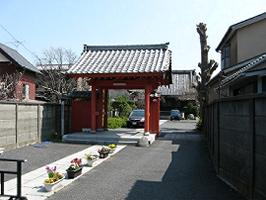
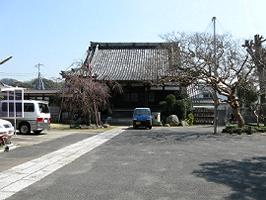
Full name: Hokkesan Honkoji (法華山本興寺)
Denomination: Nichiren sect (日蓮宗)
Location: 0.7 kilometers south-southeast of JR Kamakura Station
Grounds and structures: Behind the Sammon gate is the Main Hall, which houses Sambo-soshi (三宝祖師), a statue of Nichiren made in the Edo period, and a statue of Nichiju (日什), the founding priest of the temple. Taishido Hall (太子堂) also stands within the grounds.
The temple treasure is a Letter of Donation by Tokugawa Ieyasu (徳川家康, 1542-1616), who in 1591 endowed the temple with an estate.